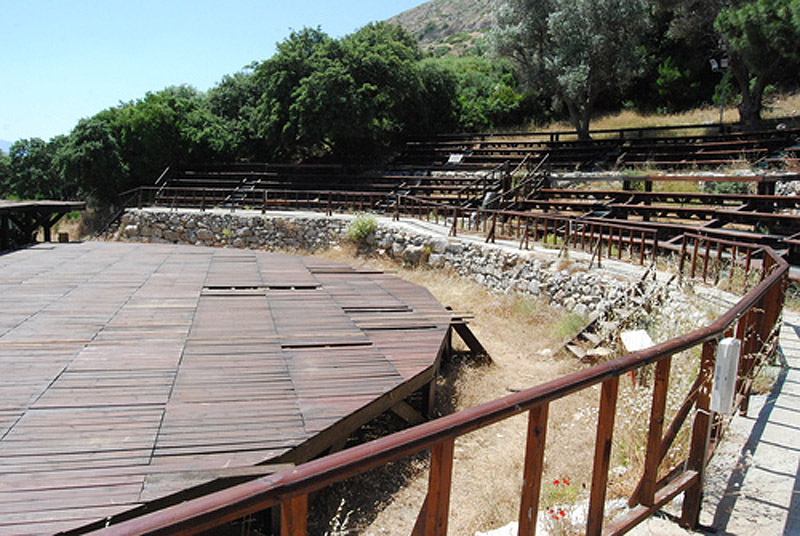
The theatre is built on the hillside of the Monastery of Panagia Spiliani (the Virgin of the Cave) in Pythagoreion, Samos. Few remains of the theatre have come to light. It was built during the Roman period and appears to have consisted of a cavea, orchestra and stage building. Very little of the theatre stonework survives. The terrain and its terracing permit us to identify a specific part of the site as the cavea. The stonework, which came to light during the 1996 excavation, is limited to a row of squared-off stone slabs in front of the stage. Just on the north edge of the stone paving was discovered a floor substratum and the remains of marble slab paving. A rectangular space with a slab floor, set on a lower level than the paved areas and in the centre of the row of stone slabs, may have been the prompter’s box. The foundations of the parascenia were uncovered further south. Only a single stone seat was found on the site. Obviously the stonework of the theatre was removed, probably to provide building materials for later structures of the city. Today there is a new wooden structure with an orchestra and seating on the spot, with a capacity of approximately 750 spectators.
Theatre of the ancient city of Samos (modern-day Pythagoreion)
Theatre
There are plans and drawings of the ancient building remains revealed during the excavation carried out by the 21st Ephorate of Prehistoric and Classical Antiquities in 1996, as well as photographic records.
Unpublished
The monument must have consisted of a cavea, orchestra and stage building. Very little of the theatre stonework survives. The terrain and its terracing permit us to identify a specific part of the site as the cavea. The stonework, which came to light during the 1996 excavation, is limited to a row of squared-off stone slabs in front of the stage. Their upper surfaces bear carved circular depressions with a rectangular central socket, obviously indicating the site of a colonnade. In the exact centre of the north edge of the stone paving was discovered a floor substratum and the remains of marble slab paving. A rectangular space with a slab floor, set on a lower level than the paved areas and in the centre of the row of stone slabs, may have been the prompter’s box. The foundations of the parascenia were uncovered further south. They were built of marly limestone, a local material used for building foundations in ancient Samos. Only a single stone seat was found on the site, while another, now situated in a large hotel in Pythagoreion, probably comes from the theatre. Obviously the stonework of the theatre was removed, probably to provide building materials for later structures of the city.
Today there is a new wooden structure with an orchestra and seating on the spot, with a capacity of approximately 750 spectators. The excavation trenches have been filled in by decision of the Ministry of Culture. The function of the above-ground vaulted structure preserved on the site has not yet been determined; it is unclear whether it is connected to the theatre or to some water-supply system of the Roman city.
A rescue excavation was carried out on the site of the ancient theatre in 1996. By decision of the Ministry of Culture and with funding from the Archaeological Receipts and Expropriations Fund, via a project contract with Pythagoreion Municipality, the excavation trenches were filled in and a wooden structure, with a capacity of approximately 750 spectators, was erected on the spot. Seats were placed in the cavea, a raised wooden stage in the orchestra, and wooden cabins for artists and spectators (dressing rooms, toilets, snack bar) in the area of the parascenia. The stones found in situ were left there.
Cultural events
Performances have been held on the site since the 1980s, with the audience sitting on the ground. After 1996, when the site was excavated and filled in again, by decision of the Ministry of Culture and with funding from the Archaeological Receipts and Expropriations Fund, via a project contract with Pythagoreion Municipality, the excavation trenches were filled in and a wooden structure with an orchestra and seating was erected. In recent years many events have been held on the site as part of the Manolis Kalomiris Festival of Samos Prefecture, and the Heraia-PythagoreiaFestival of Pythagoreion Municipality, Samos.
The site of the ancient theatre is a monastic estate. It has formed part of the Pythagoreion archaeological site since 1963 and the non-built-up protection zone A of the ancient city of Samos since 1991, while it has been a UNESCO World Heritage Site since 1992, along with the whole of Pythagoreion and the Heraion of Samos.
The excavation was carried out by archaeologist M. Viglaki-Sofianou of the 21st Ephorate of Prehistoric and Classical Antiquities.
–
–
–
–
| Name | Date | Amount (€) |
|---|---|---|
| Petros Themelis | 350.00 | |
| Michaelia Karabela | 50.00 |